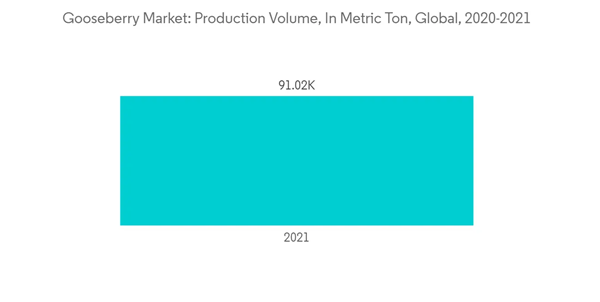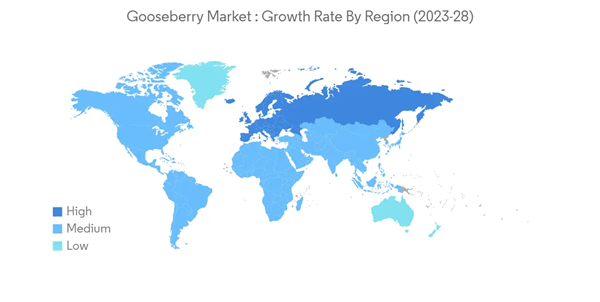The Global Gooseberry Market size is estimated at USD 1.54 billion in 2024, and is expected to reach USD 1.92 billion by 2029, growing at a CAGR of 4.60% during the forecast period (2024-2029).
This product will be delivered within 2 business days.
Key Highlights
- The demand for gooseberry is growing due to increasing health awareness. This, coupled with the wide usage of fresh gooseberries in food &beverage, cosmetic &personal care, and dietary supplements industries, supports market growth.
- An increase in health consciousness among people is the key growth driver of fresh gooseberries. Various nutrients in fresh berries, such as protein, potassium, magnesium, copper, manganese, iron, and vitamin B6, are increasing in demand. Some berries are rich in fiber, which helps in blood sugar control and enhances the function of the digestive system. Fresh gooseberries offer various health benefits, due to which their consumption is increasing. For instance, gooseberry helps in curing Type-2 diabetes.
- Additionally, the market value for natural and organic cosmetics and personal care is increasing faster, which is expected to increase the usage of gooseberries in the cosmetics industry even more.
Gooseberry Market Trends
Incresaing Gooseberry Consumption for Health Benefits
- Gooseberries are high in the nutritional content of protein, potassium, magnesium, copper, manganese, iron, and vitamin B6. The oval gooseberries are white, red, yellow, or green, usually with a prickly or hairy surface. Gooseberries are also rich sources of dietary fiber as they possess a wide array of bioactive components. Apart from vitamins, fibers, and minerals, these bioactive compounds, such as phenolics, tannins, and flavonoids, are also present in berries. An increase in health consciousness and desire to stay fit among people, coupled with many health benefits associated with the berries, is fueling the growth of the berries market.
- The gooseberry berries have health benefits and prevent various chronic illnesses like cancer and heart diseases. Gooseberries are rich in antioxidants, whereas berries increase antioxidant levels and reduce the risk of metabolic diseases, including obesity and type-2 diabetes.
- Additionally, consumers prefer more natural, authentic, organic, and less processed food, increasing the demand for organic berries. The increasing awareness among consumers about the nutritional benefits of organic berries and their usage in ready-to-drink (RTD) and ready-to-eat (RTE) products has significantly stimulated market growth.
Europe Dominates the Market
- Europe is the major market for gooseberries, accounting for 90% of the global share in production. European and American gooseberry varieties are widely produced and consumed in the region.
- Due to the increased domestic demand and exports, production has increased over the years. For instance, according to Food and Agriculture Organization (FAO), the production of gooseberries in 2019 was 80,512 Metric tons and increased to 90,904.3 metric tons in 2021. Russia, Ukraine, and the United Kingdom dominate the production in the region, to which Russia contributes 87%. This increased production leads to exports. Ukraine, Kazakhstan, and Mongolia were the main destinations of gooseberry exports from Russia, comprising 99% of total exports.
- Further, health concerns among consumers in the country are increasing. The National Library of Medicine states that Berries make a significant contribution to providing the body with vitamin C. Including 100 g of fresh fruit in the diet provides about 10% of the recommended dietary intake for potassium (apricot, gooseberry, cherry, and black currant), magnesium (apple, cherry, strawberry) and dietary fiber.
Additional Benefits:
- The market estimate (ME) sheet in Excel format
- 3 months of analyst support
This product will be delivered within 2 business days.
Table of Contents
1 INTRODUCTION
4 MARKET DYNAMICS
5 MARKET SEGMENTATION










